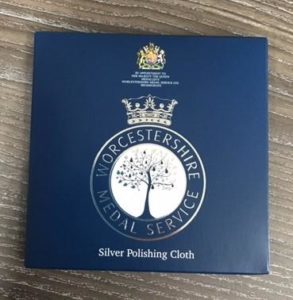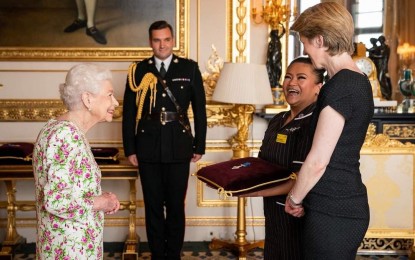GEORGE CROSS AWARD-HEALTH SERVICE | ENGLAND, U.K.- Filipina nurse receives George Cross from Queen Elizabeth
GEORGE CROSS AWARD. Queen Elizabeth II (left) presents the George Cross to Filipina nurse May Parsons (2nd from right) at Windsor Castle on July 12, 2022. Parsons administered the first Covid-19 vaccine outside of clinical trials to Maggie Keenan on Dec. 8, 2020. (Photo courtesy of The Royal Family)
…


George Cross Ribbon Emblem
.
The Filipina nurse who first administered the COVID-19 vaccine has received the George Cross from Queen Elizabeth II and Prince Charles, during an audience at Windsor Castle on Tuesday (July 12).
May Parsons, along with National Health Service (NHS) CEO Amanda Pritchard, received the highest award for gallantry on behalf of the more than 1.5 million NHS staff in England.
Ads by:
Memento Maxima Digital Marketing
@[email protected]
SPACE RESERVE FOR ADVERTISEMENT
PROUD PINAYS:
The Queen had a lighthearted moment with her quests as she cracked a joke with NHS leaders and healthcare while hosting the ceremony.
She joked with Parsons about her historic first, saying, “You’re still alive?”
“We’re terribly, terribly proud of the vaccination roll-out, it was so successful,” Parson told the Queen, laughing.
“Yes it was amazing. And what are you going to do with it [medal]?” Her Majesty replied.
“All of the staff in hospitals and our communities went above and beyond during the pandemic to look after patients despite the risks the virus posed to themselves, across health and care, staff sacrificed so much to look after those in need,” Parsons said in a statement. “The George Cross is a fitting tribute to them all.”
Ads by:
Memento Maxima Digital Marketing
@[email protected]
SPACE RESERVE FOR ADVERTISEMENT
Personally, Parsons said that she’s deeply honored to represent dedicated health workers and staff in the NHS.
“I’m deeply honored to represent the wonderful and dedicated people within the NHS and Social Care who have shown up everyday to care for our people and communities despite the challenges and sacrifices we’ve had to take posed by the COVID-19 Pandemic,” Parsons said in a Facebook post.
The George Cross, first introduced in 1940, is the highest award given by the British government to citizens who have shown great acts of gallantry outside the context of warfare, whose equal award for bravery in the military is the Victorian Cross.
The award is given in recognition of “acts of the greatest heroism or the most courage in circumstances of extreme danger.”
In receiving the award, Parsons said that it is also a tribute to health workers who succumbed to the virus, for their bravery in the midst of the greatest threat in the health and healthcare system of everyone around the world.
“We remember our fallen colleagues who has given the ultimate sacrifice and I cannot be more proud of our achievements as a whole. The George Cross is a fitting tribute as we continue to fulfill our pledge to care and to serve our communities,” Parsons added.
Ads by:
Memento Maxima Digital Marketing
@[email protected]
SPACE RESERVE FOR ADVERTISEMENT
Parsons administered the world’s first COVID-19 vaccination to 90-year-old grandmother Margaret Keenan.
She said that she was “very proud to say to everyone I am a Filipino-Briton making history”.
“I am really glad to be telling all the Filipinos, in this country and everywhere in the world, we can make a difference and we do offer positive contributions to humanity, as it were. I think it is a historical event for Filipinos all across the globe for making sure that we are proud of what we have achieved and what we contribute to everyone and the care we give”, Parson told Good Morning Britain.
Marvin Joseph Ang is a news and creative writer who follows developments in politics, democracy, and popular culture. He advocates for a free press and national democracy. The views expressed are his own.
.
TRIVIA:
George Cross
| George Cross | |
|---|---|

Obverse of the cross. Ribbon: 1½”, dark blue
|
|
| Type | Civil decoration |
| Awarded for | “… acts of the greatest heroism or of the most conspicuous courage in circumstances of extreme danger.” |
| Description | Height 48 mm, max. width 45 mm; (Obverse) plain silver cross with circular medallion in the centre depicting the effigy of St George and the Dragon, surrounded by the words “FOR GALLANTRY”. In the angle of each limb is the Royal Cypher GVI; (Reverse) plain, centre engraved with name of recipient and date of award. Cross attached by ring to bar ornamented with laurel leaves, through which the ribbon passes. |
| Presented by | Monarch of the United Kingdom |
| Eligibility | Commonwealth subjects |
| Post-nominals | GC |
| Status | Currently awarded |
| Established | 24 September 1940 |
| Last awarded | 16 June 2017 (gazetted)[1] |
| Total | 409 (including 3 collective awards) |
| Total awarded posthumously | 90 (including 5 former EGM recipients) |
| Total recipients | 409 (including 3 collective awards) |
GC ribbon bar
|
|
| Order of Wear | |
| Next (higher) | Victoria Cross[2] |
| Next (lower) | Order of the Garter |
| Related | George Medal and Queen’s Gallantry Medal |
The George Cross (GC) is the highest award bestowed by the British government for non-operational gallantry or gallantry not in the presence of an enemy. In the British honours system, the George Cross, since its introduction in 1940, has been equal in stature to the Victoria Cross, the highest military gallantry award.[3] It is awarded “for acts of the greatest heroism or for most conspicuous courage in circumstance of extreme danger”,[4] not in the presence of the enemy, to members of the British armed forces and to British civilians.[5] Posthumous awards have been allowed since it was instituted. It was previously awarded to residents of Commonwealth countries (and in one case to Malta, a colony that subsequently became a Commonwealth country), most of which have since established their own honours systems and no longer recommend British honours. It may be awarded to a person of any military rank in any service and to civilians including police, emergency services and merchant seamen. Many of the awards have been personally presented by the British monarch to recipients or, in the case of posthumous awards, to next of kin. The investitures are usually held at Buckingham Palace.
Creation
The George Cross was instituted on 24 September 1940 by King George VI.[7] At this time, shortly after the climax of the Battle of Britain and during the third week of the Blitz, there was a strong desire to reward the many acts of civilian courage. The existing awards open to civilians were not judged suitable to meet the new situation, therefore it was decided to institute the George Cross and the George Medal to recognise civilian gallantry in the face of enemy action, and brave deeds more generally.
Announcing the new award, the King said:
In order that they should be worthily and promptly recognised, I have decided to create, at once, a new mark of honour for men and women in all walks of civilian life. I propose to give my name to this new distinction, which will consist of the George Cross, which will rank next to the Victoria Cross, and the George Medal for wider distribution.[8]
The medal was designed by Percy Metcalfe. The Warrant for the GC (along with that of the George Medal), dated 24 September 1940, was published in The London Gazette on 31 January 1941.[9]
The King in his speech announcing the new award, stated that it would rank next to the Victoria Cross. This was second on the Order of Wear, much higher than the then existing awards for bravery not in the presence of the enemy, the highest being the two-class Albert Medal (AM); and the lowest being the single class Empire Gallantry Medal (EGM). In a substitution of awards unprecedented in the history of British decorations, holders of the EGM were required to exchange their insignia for the GC,[10][11] most receiving their replacement GC at a formal investiture. The four honorary EGM awards to foreigners were not exchanged and could therefore continue to be worn.[12] In 1971, surviving recipients of the Albert Medal and the Edward Medal (EM) became George Cross recipients, but unlike the EGM exchange of insignia, they had the option of retaining their original insignia. Of the 64 holders of the Albert Medal and 68 holders of the Edward Medal eligible to exchange, 49 and 59 respectively took up the option.
Award
The GC, which may be awarded posthumously, is granted in recognition of:
acts of the greatest heroism or of the most conspicuous courage in circumstances of extreme danger.[16]
The award is for civilians but also for military personnel whose actions would not normally be eligible to receive military awards, such as gallantry not in the face of the enemy. The Warrant states:
The Cross is intended primarily for civilians and award in Our military services is to be confined to actions for which purely military Honours are not normally granted.[17]
The Cross shall be worn by recipients on the left breast suspended from a ribbon one and a quarter inches in width, of dark blue, that it shall be worn immediately after the Victoria Cross and in front of the Insignia of all British Orders of Chivalry.[18]
When the Cross is worn by a woman, it may be worn on the left shoulder, suspended from a ribbon fashioned into a bow.[18]
In June 1941 the specification of the ribbon width was amended to one and a half inches.[19]
Bars can be awarded for further acts of bravery meriting the GC, although none have yet been awarded. In common with the Victoria Cross, in undress uniform or on occasions when the medal ribbon alone is worn, a miniature replica of the cross is affixed to the centre of the ribbon, a distinction peculiar to these two premier awards for bravery. In the event of a second award, a second replica would be worn on the ribbon.[20]
Recipients are entitled to the postnominal letters GC.[21]
All original individual GC awards are published in The London Gazette.[22]

Ads by: Memento Maxima Digital Marketing
@[email protected]
SPACE RESERVE FOR ADVERTISEMENT










